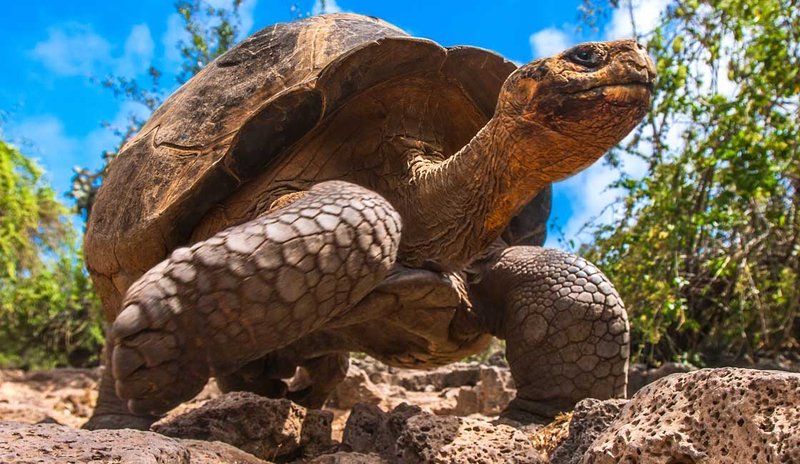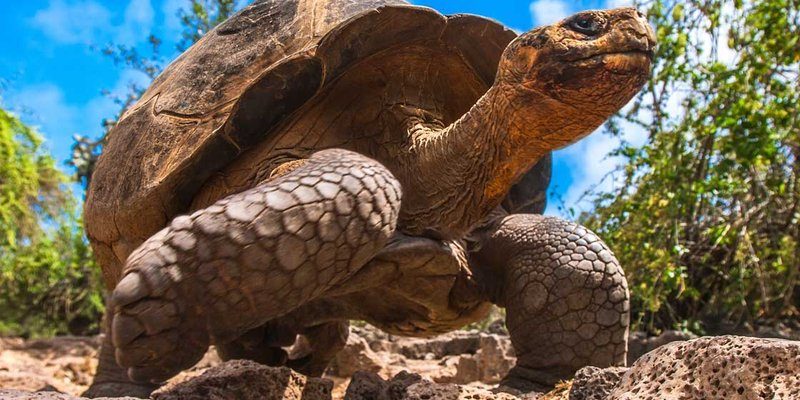
The Galápagos tortoise is more than just a giant reptile; it’s a living piece of history. These amazing creatures are among the largest tortoises in the world and can live for over a century. Imagine walking alongside a creature that has seen the world change over a hundred years! Found exclusively in the Galápagos Islands, these tortoises have played a crucial role in the island’s ecosystem and have fascinating stories to tell.
But what makes the Galápagos tortoise so special? Their unique adaptations, interesting behaviors, and conservation status are just a few aspects worth exploring. If you’ve ever been curious about these gentle giants, you’re in for a treat. Let’s dive into their remarkable world!
Physical Characteristics
When you think of the Galápagos tortoise, the first thing that probably comes to mind is their impressive size. These tortoises typically weigh between 250 to 600 pounds, with some individuals even tipping the scales at over 1,000 pounds! Their shells are particularly striking, featuring a dome-like shape that provides robust protection. Depending on their subspecies, the shape of their shell can vary—some are more domed while others have a saddle shape that allows them to stretch their necks to reach higher vegetation.
The skin of the Galápagos tortoise is just as fascinating. It’s covered in rugged scales that help protect them from the harsh elements of their environment. These tortoises can be various shades of brown and grey, allowing them to blend into their surroundings. This natural camouflage offers them some protection from predators, although adult tortoises have very few natural enemies due to their massive size.
If you ever find yourself observing a Galápagos tortoise, you’ll also notice their big, soulful eyes. These expressive features give them an almost wise appearance, as if they’re pondering the secrets of the universe. It’s quite a sight to behold!
Habitat and Range
The Galápagos tortoise is native only to the Galápagos Islands, a remote archipelago located about 600 miles off the coast of Ecuador. This unique setting has shaped their behavior and adaptations. The islands themselves are like a living laboratory, showcasing various environments from arid lowlands to lush highlands. Each subspecies of the tortoise has evolved to thrive in its specific habitat.
In the lowlands, you’ll find tortoises roaming the dry, scrubby landscapes where they munch on cacti and other hardy plants. In contrast, those in the highlands are more accustomed to the cooler, moist environment, feasting on grasses and leafy plants. This adaptability is a key reason why the Galápagos tortoise has survived various ecological changes over the years.
| Characteristic | Description |
|---|---|
| Size: | 250 to 600 pounds, with some exceeding 1,000 pounds. |
| Lifespan: | Over 100 years. |
| Habitat: | Exclusively on the Galápagos Islands, in various environments. |
| Diet: | Herbivore, primarily grazing on grasses, cacti, and leaves. |
| Speed: | Can move up to 0.3 miles per hour. |
Behavior and Diet
Now, let’s talk about how these gentle giants go about their day. Galápagos tortoises are primarily herbivores, relying on a diet of grasses, fruits, and leaves. They have strong, beak-like jaws that allow them to easily munch on tough vegetation. Interestingly, their diet can vary depending on the availability of food in their specific habitats. For instance, some tortoises may favor cacti when other food sources are scarce.
You might be wondering about their daily activities. Galápagos tortoises are known for leading a slow-paced life. They spend a good part of their day basking in the sun, which helps regulate their body temperature. You would imagine they just lounge around, but they’re quite the foragers. They roam their habitats in search of tasty plants, illustrating the old saying, “slow and steady wins the race.”
Social behaviors among tortoises can be quite interesting as well. While they are generally solitary, they do interact during mating season. Males are known to engage in head-bobbing and vocalizations to attract females. It’s a slow and deliberate courtship, reflecting the overall lifestyle of the Galápagos tortoise.
Reproduction and Lifespan
When it comes to reproduction, Galápagos tortoises have a fascinating life cycle. Mating season varies depending on the specific island, but generally occurs during the warmer months. Females can lay anywhere from 2 to 16 eggs in a single clutch. After laying their eggs, they bury them in the sand and leave them to incubate for about 120 to 150 days, relying on the warm sun to nurture the developing embryos.
After hatching, baby tortoises are left to fend for themselves, which sounds harsh but is completely normal in the wild. The hatchlings are incredibly vulnerable, facing threats from various predators, including birds and rats. Those that survive can lead incredibly long lives, often exceeding a century. Some individuals have even been documented living more than 170 years!
This longevity is remarkable and gives us insight into the health and resilience of the species. Just think about it—a creature that can live through multiple generations of change, bearing witness to the passage of time and the evolution of their habitat. It truly drives home the importance of protecting their environment.
Conservation Status
Sadly, the Galápagos tortoise is not without its challenges. Once facing imminent extinction due to overexploitation by sailors and introduced species, the tortoise population saw a dramatic decline. Conservation efforts have been underway for decades to help recover their numbers. Today, many tortoise populations are protected, and significant steps have been taken to restore their habitats.
Organizations and conservationists have been working tirelessly to create breeding programs and rehabilitate tortoises for release back into the wild. This has shown promising results, and some populations are gradually increasing. However, ongoing challenges such as habitat loss and climate change still pose significant threats. The Galápagos tortoise is a symbol of conservation efforts, highlighting the need for continued vigilance.
Efforts to educate the public about these amazing creatures also play a crucial role in their conservation. By raising awareness, we can promote responsible tourism and encourage more people to contribute to conservation initiatives. Protecting the Galápagos tortoise isn’t just about saving a species; it’s about preserving an entire ecosystem for future generations.
FAQ
What is the main diet of the Galápagos tortoise?
The Galápagos tortoise primarily consumes a variety of plant materials, including grasses, fruits, and leaves. Their jaw structure allows them to eat tough vegetation, making them well-suited to their environment. They can also ingest cacti, which provides them with moisture in the arid conditions of their habitats.
How long do Galápagos tortoises typically live?
Galápagos tortoises are known for their impressive longevity. They can live for over 100 years, with some individuals recorded to exceed 170 years. Their slow metabolism and lifestyle contribute to this remarkable lifespan, allowing them to thrive in their natural habitat for decades.
Are Galápagos tortoises social animals?
While Galápagos tortoises are primarily solitary, they do exhibit social behaviors during mating season. Males engage in displays to attract females and may participate in brief interactions. Outside of mating, they tend to live independently, only coming together in areas with plentiful food resources.
Why are Galápagos tortoises considered endangered?
Once on the brink of extinction, Galápagos tortoises faced threats from human activities, such as hunting and habitat destruction. The introduction of invasive species also had a devastating impact on their populations. Although conservation efforts have been initiated, they are still classified as endangered because they continue to face risks from climate change and habitat loss.
How can I help with Galápagos tortoise conservation?
Supporting organizations dedicated to wildlife conservation can make a significant impact. This includes donating or volunteering for projects aimed at protecting the Galápagos tortoise and its environment. Additionally, being a responsible traveler by respecting wildlife and their habitats during visits to the Galápagos Islands helps ensure their protection.
What are the main threats to the Galápagos tortoise’s survival?
The main threats include habitat destruction, climate change, and the presence of invasive species that compete for resources. Additionally, illegal hunting and poaching continue to pose risks for tortoise populations. Conservation efforts are vital to mitigating these threats and ensuring their survival.
How do Galápagos tortoises adapt to their environment?
Galápagos tortoises have developed unique adaptations to thrive in their specific habitats. Some have developed elongated necks, allowing them to reach higher vegetation. Others exhibit differing shell shapes based on their island environments, showcasing their incredible adaptability to varying ecological conditions.
Can Galápagos tortoises swim?
While Galápagos tortoises are primarily land-dwelling creatures, they are capable of swimming if necessary. They can move through water using their buoyant bodies and paddling their legs. However, they are not natural swimmers and prefer to remain on solid ground.
What is the significance of the Galápagos tortoise in ecosystems?
Galápagos tortoises play an essential role in their ecosystems by grazing on vegetation, which helps maintain the health of their habitats. Their foraging behavior creates open spaces for other plants to grow and encourages biodiversity. By contributing to their environment, they help sustain the delicate balance in the Galápagos Islands.
Are there different subspecies of Galápagos tortoises?
Yes, there are several subspecies of Galápagos tortoises, each adapted to the unique conditions of their specific island habitats. These subspecies differ in size, shell shape, and diet, showcasing the incredible diversity of these remarkable creatures. Conservation efforts focus not just on the species as a whole but also on preserving the genetic diversity within its subspecies.
What can tourists do to protect Galápagos tortoises?
Tourists can contribute to the conservation of Galápagos tortoises by following guidelines set by local conservation authorities and by practicing responsible tourism. This includes not disturbing wildlife, staying on designated paths, and supporting local eco-friendly businesses that prioritize sustainability and conservation efforts.

